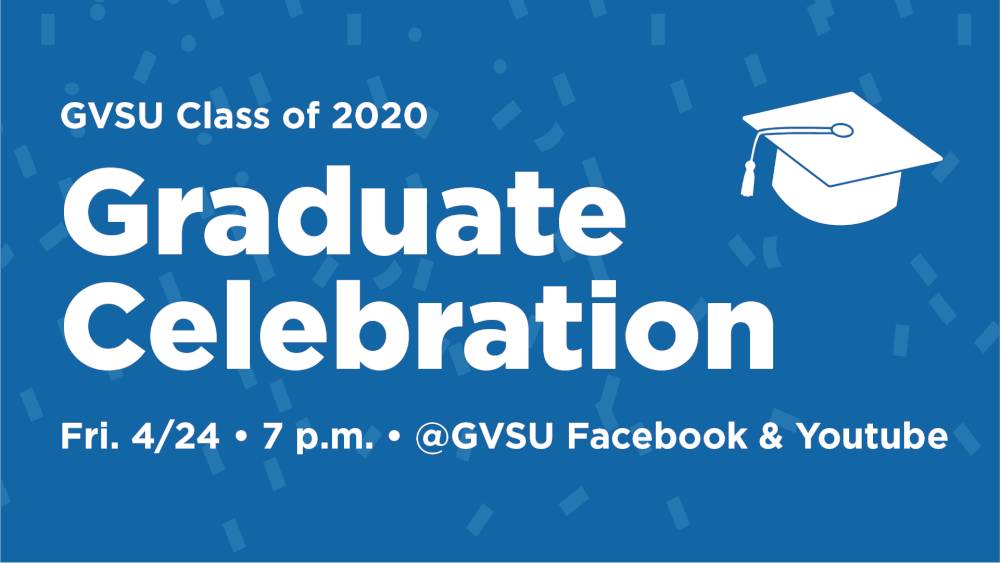GVSU Social Blog
Permanent link for Tips for creating content when you're crunched for time on May 24, 2021
Anyone who has spent some time developing a social media calendar or writing Tweets knows that social media can be a time consuming task. During busy times, it’s easy for social media to fall by the wayside. Here are some tips to help you create top notch content when you’re in a rush.
For Quick Visuals
Including some kind of imagery with a social media post is critical to catching the eye of your audience, but unless you have a graphic designer or photographer on your team, that content can be hard to come by.
Luckily, GVSU’s photo database in Widen is a great place to start. There are thousands of approved images already on the site that you can pull from for nearly anything you can think of!
If a photo isn’t quite what you’re looking for, we recommend checking out Canva for creating quick, professional-looking graphics.
Canva provides multiple pre-made templates, font families, and color schemes all for free! You can also upload assets, such as the GVSU logo, to incorporate into the graphic.
Just remember to follow GVSU’s brand guidelines as much as possible when creating images in Canva.
Edit Content Like a Pro, Right From Your Phone
If you use an iPhone, the iMovie app was likely automatically downloaded on your device. This app has a surprising amount of video editing features, including animated text and flashy transitions. It’s a great option if you’re looking to add some quick pizzazz to a video you captured on your phone.
Lightroom and Photoshop both have apps that can be downloaded for free to your phone if you already have an Adobe Creative Cloud subscription. This will allow you to make detailed edits to your photos on the go.
Don’t have access to Adobe Creative Cloud? Never fear! The native editor in the photo app on both iPhones and Android devices can be a great place to start, and the VSCO app also provides pretty good editing options at no cost.
Reduce, Reuse, Recycle
Though we don’t recommend making a habit of reusing content, sometimes a post will be so good that it warrants being shared again.
Refrain from sharing the same graphic, image or video multiple times in a short period, as this can seem repetitive or spammy to your followers.
Instead, check through your archives of saved photos, graphics and videos to dig up content that hasn’t been used in awhile that still might resonate with your followers.
Twitter can be a great platform to recycle content on when appropriate, due to it’s fast-moving nature. We recommend never sharing the same content twice on Instagram, as it’s easy for your followers you view repeated posts on your profile.
Leverage free scheduling platforms
Keeping a consistent presence on all social media platforms is critical to keeping your audience engaged. Scheduling posts is a great way to ensure you’re posting frequently, without the stress of constantly finding time to craft posts.
Carve some time out of each week or month to schedule some posts. Free tools such as Facebook Creator Studio and Tweetdeck make scheduling a breeze.
A word of caution: Be aware that the world of social media can change in an instant, and it’s important to be prepared to remove scheduled posts if they are no longer appropriate to share. We recommend making a weekly check-in on your list of scheduled posts to make sure they are all still relevant and appropriate.
Categories:
best practices
Posted
by
Anna Young
on
Permanent link for Tips for creating content when you're crunched for time on May 24, 2021.
Permanent link for The dos and don'ts of running a social media giveaway on April 21, 2021
Giveaways can be a fun way to engage with your followers on social media. At Grand Valley, we love showing Lakers some love by giving out gift cards, apparel and more!
But wait - before you hit send on that giveaway Tweet, it’s important to review the rules put in place by various platforms to ensure your giveaway complies with all guidelines.
Let’s review some ground rules for hosting a giveaway on some of social media’s most popular platforms.
Twitter guidelines are pretty giveaway-friendly, and is University Communications’ preferred platform for hosting a giveaway.
DON’T:
- Require users to create multiple Twitter accounts in order to enter the giveaway.
- Encourage posting the same Tweet repeatedly in order to win the giveaway. (a.k.a spam posting)
DO:
- Encourage users to mention you (by using the @ sign with your username) in their entry.
- Use relevant hashtags to help aggregate giveaway entries.
- Create giveaways that spur engagement through likes, retweets and replies.
More specifics on Twitter guidelines can be found here.
Instagram is often the platform of choice for hosting a giveaway, given its many options for entry, including likes, comments, mentions and sharing to Instagram Stories.
DON’T:
- Be vague about the rules of the contest. This goes for all platforms, but is especially important on Instagram. Text is featured under images, and is often not read as carefully as it is on other platforms.
- Make it too complicated to enter. Entries for an Instagram giveaway typically include tagging a friend in the comments or quickly sharing a post to your Instagram story. Asking a user to post a photo on their profile may be too much work for many users.
DO:
- Include in the text of your giveaway a statement acknowledging that the giveaway is not sponsored, administered, endorsed by or associated with Instagram in any way. This rule may seem pretty strict, but please remember to include it every time!
Further information on Instagram promotions can be found here.
Giveaway guidelines on Facebook are generally similar to Instagram.
DON’T:
- Ask users to share a post on the Timeline to enter.
- Ask users to tag their friends in comments to enter.
DO:
- Include in the text of your giveaway a statement acknowledging that the giveaway is not sponsored, administered, endorsed by or associated with Facebook in any way.
Facebook promotion guidelines are listed here.
Have more questions about the rules of a social media giveaway? Contact us at [email protected].
Categories:
best practices
Posted
by
Anna Young
on
Permanent link for The dos and don'ts of running a social media giveaway on April 21, 2021.
Permanent link for Four tips to make your social media content more accessible on March 4, 2021
Social media should be accessible for all, but that’s often not the case.
Leaving out alt-text, overusing emojis and writing in all-capital letters are all errors we’ve made while creating social media content.
It’s on us as social media managers to stay up-to-date on best accessibility practices. When accessibility is left out of a social media strategy, it’s a missed opportunity to connect with members of your audience.
Follow the four tips below to create more accessible social media content.
Include image descriptions
Writing an alternate description, also known as alt-text, helps people visualize an image when they can’t see it.
Twitter, LinkedIn, Instagram and Facebook have specific fields to add alt-text for images and GIFs. Include descriptive captions in post copy when providing alt-text is not possible.
Remember to transcribe copy in the image, if it is crucial to understanding the image (example: a graphic or chart).
Make sure videos have captions
Captioned videos assist people with hearing impairments, but they can also help people watching with the sound off or those who are learning the language the video is in.
How do you add captions? Here’s a guide from Hootsuite.
- Facebook: Auto-generate captions, write them yourself, or upload a SubRip (.srt) file. Automatic closed captioning is also available for Facebook Live and Workplace Live.
- YouTube: Auto-generate captions, transcribe them, or upload a supported file. Errors can be corrected with the caption editor. Automatic captions are available in English for YouTube Live.
- Instagram: Automatic closed captioning is available for IGTV Live and IGTV. For stories, there is a "sticker" that automatically transcribes the video and adds captions. Video captions must be added to in-feed posts in advance.
- Twitter: Upload an .srt file with your video.
- LinkedIn: Upload an .srt file with your video.
A paid service University Communications uses for generating SRT files is rev.com.
Write hashtags in “Camel Case”
Capitalize the first letter of each word in a hashtag to make it more legible for everyone and prevent screen reader issues.
Instead of writing hashtags #LIKETHIS or #likethis, make sure to #WriteLikeThis, a practice often referred to as “Camel Case.”
Writing in all capital letters can be misinterpreted by all, so it’s best to not overuse them. Include hashtags and @mentions at the end of copy, as they can disrupt the caption.
Don’t use fancy characters or emojis in the middle of copy
Consider how special characters and emojis sound they are read by a screen reader.
Special characters that create different fonts on social media sound jumbled, and emojis are read as their descriptions. Example: “pleading face” and “dizzy.” Before using emoji in social media copy, check Emojipedia to learn how it translates to text.
Categories:
best practices
strategy
Posted
by
Meagan Saxton
on
Permanent link for Four tips to make your social media content more accessible on March 4, 2021.
Permanent link for Social media lessons learned in 2020 on December 22, 2020
In a year where many people engaged in more virtual activities than ever before, social media increasingly became a tool to share important information with the Grand Valley community.
As 2020 comes to a close, now is a time to reflect on lessons learned from this memorable and challenging time.
Here are a few bits of social media wisdom from this year to remember in the new year and those to come.
Clarity is key
Whether it was a change in campus policies or an update on statewide health orders, being crystal clear in the delivery of campus-wide messages is essential.
Put yourself in your follower’s shoes, and craft content that helps to address pertinent information in direct, yet still creative ways.
Sharing Twitter threads, Instagram Stories and Facebook updates with links to further reading can help your followers feel informed and cared for.
Managing social media platforms is often a customer service role, so when making announcements, be ready to answer questions and respond to comments in order to be as helpful as possible.
Read the room
During challenging times, take a pause before posting and consider what will best serve your followers. Trust your instinct; if it doesn’t feel like the appropriate time to share something, your gut is probably right.
Sometimes, your followers will love a photo of a cute puppy, but other times, it’s best to say nothing at all.
Don’t be afraid to look at your content schedule with a critical eye to best decide what needs to be prioritized to best serve followers, and what should wait for a better time.
Be flexible
Having a content calendar is an extremely helpful tool for crafting a cohesive social media content, and maintaining a solid strategy in chaotic times is important.
However, the ability to be flexible during unique times is paramount for creating successful social media content.
Be ready to move posts around day-to-day as needed, and in times of crisis, limit the number of pre-scheduled posts. Scheduling a post that ends up going live moments after a serious news headline starts trending can come off as tone deaf, even if that wasn’t the intention.
As always, the GVSU social team is here to support you. Never hesitate to reach out with questions or concerns!
Categories:
best practices
Posted
by
Anna Young
on
Permanent link for Social media lessons learned in 2020 on December 22, 2020.
Permanent link for Building a College President's Social Media Presence on May 28, 2020
Written by Anna Young
After beginning her tenure as president of Grand Valley State University in 2019, Philomena V. Mantella became the first president at GVSU to have social media. She has a professional presence on Twitter, Instagram, and LinkedIn.
Managing social media for an individual is very different from an institutional account. Here are a few tips the Grand Valley social media team has learned along the way.
Assemble a Team
President Mantella’s busy schedule gives ample opportunity for great social content but doesn’t allow her time to manage her social media accounts on her own. It quickly became evident that in order to grow a strong following and consistently create high-quality posts, support was needed.
Our social team monitors President Mantella’s social media each day to share content and monitor engagements. Maintaining an active presence on social media has been key to growing the following on all of these accounts.
Building a close relationship with the president’s office has been essential to curating strong content for social media. The president’s office will keep the social media team updated on President Mantella’s schedule, and assist in sharing relevant content with us as needed.
Identify Your Goals
Being new to the role of president, the strategy around President Mantella’s accounts is focused on accurately demonstrating her priorities as a leader, and fostering a strong relationship with the GVSU community.
We utilize President Mantella’s accounts to share more specific presidential initiatives that may not resonate with the broader GVSU social media audience. We’ve also seen success in sharing more personal posts, such as photos of her dog, or outings she’s had with her family.
To support building a connection with the Laker community, we regularly engage with relevant posts through likes or comments. This includes congratulating recent Laker alumni on their graduation or thanking a faculty member for going above and beyond with their students.
Make a Plan
On a weekly basis, we share the social media plan for the next week with President Mantella and a few others in her office. President Mantella has full approval of all of the content that is shared on her accounts, and often posts content on her own when she sees fit.
We’ve also collaborated with her to curate specific audience personas that she wishes to connect with on social media. This includes national leaders in higher education, and those working in innovative tech spaces around the country, including professionals at Google and Sony.
Track Analytics
To ensure the goals you’ve set are being met, it’s essential that you are regularly examining your analytics.
Being new accounts, tracking follower growth seems like it would be priority number one, but we actually focus more on engagement, impressions and reach. You can have a large following, but if they aren’t engaged, it means your content isn’t connecting with your audience.
Additionally, if you have low reach and impressions on your posts, It’s unlikely that your audience will continue to grow. The best way to ensure strong impressions is to generate timely, unique content that others will want to see.
Not sure what analytics are most important to you? Sprout created a helpful run-down of what social media metrics are, and what you should be paying attention to.
You can learn more about President Mantella and her initiatives at www.gvsu.edu/president.
Categories:
best practices
strategy
Posted
by
Anna Young
on
Permanent link for Building a College President's Social Media Presence on May 28, 2020.
Permanent link for How we hosted a virtual graduate celebration for the GVSU Class of 2020 on May 7, 2020
Written By Meagan Saxton
When GVSU President Philomena V. Mantella announced remote learning would continue through the Winter 2020 semester in response to the COVID-19 pandemic, one of the most popular questions was: what about commencement?
Celebrating our class of 2020 and their achievements was, and still is, important to us. We knew that whatever was planned – it wouldn’t be the same as an April ceremony at Van Andel Arena in Grand Rapids.
The decision made was to postpone the in-person ceremony to October and host a virtual graduate celebration on the GVSU Facebook and YouTube pages. While we have broadcasted events on YouTube, a virtual commencement was a new concept for all of us. Here is a breakdown of what we did and how we did it.
Film and edit the virtual celebration video.
We give major kudos to the GVSU video team for filming and editing the full celebration. It included a message from President Mantella, Provost Maria Cimitile, clips submitted by each of the deans of GVSU’s eight colleges, names of all the graduates (3,000+) and it closed with a musical performance from a graduating senior. The virtual celebration’s length came in just under 40 minutes.
Promote the celebration ahead of time.
Of course, we had to get the word out. President Mantella announced in a Zoom town hall with current students and on her Twitter that there would be a virtual celebration. We also posted about the celebration on all GVSU social platforms a week in advance and the day before.
Choosing the best platform for a virtual celebration: Facebook and YouTube Premiere.
We chose to host the video on our Facebook and YouTube channels because we knew a majority of our audience would be able to find the celebration on one of those pages. We also chose those two platforms for the live comment functionality. By utilizing the premiere setting on Facebook, we were able to upload the video ahead of time. Doing so created an event on the GVSU page and alerted people following the page when the video went live. The premiere setting on YouTube also allowed us to upload the video ahead of time and created a countdown screen.
Once it was time for the video to go live, the GVSU Social team watched on both platforms to make sure it went off without any issues and to monitor comments.
Additional commencement content.
We knew this was not the usual ending for graduating students, but we wanted to still celebrate our class of 2020 with commencement-specific content.
This included: an Instagram AR filter with a graduation cap; class of 2020 graphics for Facebook and Twitter headers and Instagram Stories; an infographic with the number of graduates, dean’s list students, top undergrad and graduate degrees and more. Other GVSU social accounts created content, such as congratulatory messages from GVSU alumni.
How it went.
This was a successful and unique way to celebrate the class of 2020 without hosting an in-person ceremony. Peak viewership on YouTube reached 1,284 and on Facebook it reached 958. During the time of the celebration, some of our followers posted photos of them watching while wearing their cap and gown. We retweeted and reshared some of these photos on our Instagram story. To date, the video has received more than 47,789 views of at least 3 seconds on Facebook and 8,993 views on YouTube. We’re looking forward to the day we can celebrate the class of 2020 in-person!
Watch the video on YouTube here.
Categories:
engagement
Posted
on
Permanent link for How we hosted a virtual graduate celebration for the GVSU Class of 2020 on May 7, 2020.
Permanent link for Tips for holding a contest on social media on November 11, 2019
Written By Meagan Saxton
Who doesn’t love to win — especially when a prize is involved?
Hosting a contest on social media is a great way to engage with followers and give back to them for supporting your brand/page. The GVSU Social team holds an annual #GVFall photo contest to do just that. To participate, we asked followers to include #GVFall with their fall photos of Grand Valley on Instagram or Twitter.
This year, there were more than 130 submissions for the contest, which began October 15 and submissions ended October 31. Our team selected the top six photos and posted them early November on Twitter and Instagram for GVSU followers to vote and pick the top three. The top three winners were announced two days later and the first place photo was posted on all GVSU social platforms.
Coordinating a social media contest takes just as much, if not more, planning than day-to-day posts. Here are the top three things we learned, and what we want to change for next year’s contest.
Find the time-frame sweet spot.
We accepted photos for a little more than two weeks. At first, our team thought this might be too long. Looking at how many submissions we received, we could have ended the contest a few days earlier. However, we were waiting on unpredictable Michigan weather and for the leaves to change before we started. Every contest is different, so our tip is to know what you are asking of people and give them enough time to participate.
Set an entry cap.
We loved seeing all the great campus beauty shots, however, some people submitted more than five photos. This made picking the top six difficult. If someone submitted more than one photo to the contest that our team liked, we picked our favorite from that one person to keep the top six fair. Next year, the #GVFall rules will be more clear on entries.
Create an efficient voting system.
The top six photos were posted on Twitter as a thread and as a gallery on Instagram. Counting votes from Twitter was simple, because people favorited the tweet that had their top pick. With the Instagram gallery, each photo had a number associated to it and followers were asked to comment the photo’s number to vote. The post garnered more than 700 comments, which lead to creating a spreadsheet and counting each vote by hand. In the future, finding one way for people to vote would save time and energy.
If something in your contest doesn’t go as planned, remember that part of hosting a social media contest is trial and error to learn what works best for your page and followers. Be clear and consistent with messaging and you’ll be on your way to having a successful contest!
Categories:
best practices
engagement
Posted
on
Permanent link for Tips for holding a contest on social media on November 11, 2019.
Permanent link for Creating a new social media account on October 1, 2019
The social media landscape is constantly advancing, sometimes even overnight. Organizations, clubs and departments around Grand Valley could greatly benefit from the positive exposure and self-expression that accompanies a strong social media presence. Strategically creating social media accounts has been proven to increase awareness about the mission statement, vision and goals of thousands of institutions and brands.
By creating social accounts, you get to choose how to brand your organization and the message behind it. A few notable benefits of establishing a presence on social media include increased traffic for your site, connect with your audience, and boost awareness.
Here are some important strategies to consider when creating new social media accounts:
Before you create a new account:
- You don’t have to create an account on every platform, at least not immediately.
- Focus more on platforms your target audience is engaging with.
- Set goals and objectives
- Think of what you really want the page to consist of
- What will be your “voice” and tone on social?
- What tactics will you use to gain followers?
- Do you want to incorporate contests?
If you already have accounts on social media platforms, the steps outlined below can be used to revamp and update the current content being posted.
After you’ve created a new account:
- Create a social media calendar.
This will help you keep track of important dates and content while also allowing you to craft copy in advance.
- Assign certain platforms to team members.
It can be daunting to attempt to juggle the content, strategy and managing multiple social media posts. This is especially so if you have limited resources. Delegating tasks can save a lot of time, energy, sanity, and even budget dollars for your team.
- Pay attention to the competition.
You never know what a little inspiration will strike. Keep your eyes open for new ideas and concepts that other users are sharing out on social, and how those ideas can be customized to fit your brand.
When creating content:
- Quality over quantity. The material that you put online is going to represent the entirety of your organization, so be sure to choose wisely and strategically with what content you post.
- Be consistent. Most platforms use algorithms to base each user’s
timelines off of posts and accounts they engage with the most.
- Facebook and Instagram will decrease the views of your posts on your followers timeline if the posting from your account decreases so the more consistent you are on social media, the more time you get on your follower’s timelines. However, be aware of the fine line between posting often and posting too much.
- Leverage third party sites to schedule posts.
-
- For Instagram, it has to be a business account in order to schedule future posts. For Twitter, tweets can only be scheduled using Twitter ads. But there are many sites that will do this for you.
- Some reliable websites to use for scheduling posts are: Sprout Social, Buffer and Hootsuite.
-
By staying consistent in your social strategy, content and values, your target audience will gain an understanding of the message you want to communicate. It’s all about trying to reach your designated consumer from any angle or platform that they may be using, and getting them to engage and respond in as many ways as possible.
Categories:
best practices
strategy
Posted
on
Permanent link for Creating a new social media account on October 1, 2019.


[1571072097].jpg)





